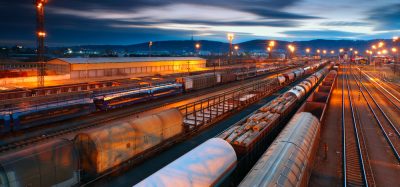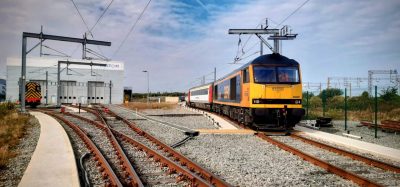Strategies aiming to double Norwegian freight traffic
Posted: 28 May 2008 | | No comments yet
Freight traffic on Norwegian railways is enjoying strong growth. All the operators on the network are reporting increased demand – signalling the need to run additional and longer freight trains. A few sections are already operating beyond their capacity. Jernbaneverket, the Norwegian National Rail Administration, is responding to this trend and proposing measures to double freight traffic over the next decade.
Freight traffic on Norwegian railways is enjoying strong growth. All the operators on the network are reporting increased demand – signalling the need to run additional and longer freight trains. A few sections are already operating beyond their capacity. Jernbaneverket, the Norwegian National Rail Administration, is responding to this trend and proposing measures to double freight traffic over the next decade.
Freight traffic on Norwegian railways is enjoying strong growth. All the operators on the network are reporting increased demand – signalling the need to run additional and longer freight trains. A few sections are already operating beyond their capacity. Jernbaneverket, the Norwegian National Rail Administration, is responding to this trend and proposing measures to double freight traffic over the next decade.
Jernbaneverket has drawn up a dedicated strategy for ensuring that freight traffic continues to grow. Besides the objective of doubling freight traffic by 2019, the strategy calls for freight services to have a 90% punctuality rate. Jernbaneverket proposes to invest NOK 3.7 billion in capacity enhancements for freight between 2010 and 2019. The key measures will be terminal expansion and additional passing loops. This strategy is underpinned by a cross-party policy objective of moving freight from road to rail in order to improve the environment, road safety and conditions for other road users. The freight strategy will form part of Jernbaneverket’s submission for the next National Transport Plan, which is to be presented to the Norwegian parliament this year.
Intermodal traffic
One distinctive feature of the Norwegian rail freight market is the very high proportion of intermodal traffic. In terms of tonnage, intermodal traffic accounts for 85%, with the remaining 15% made up of wagonload, timber and other bulk traffic. Developments have shown that a competitive concept for rail is intermodal transport of containers, semitrailers and swapbodies from Oslo to the country’s other main cities, where they are offloaded for local transport by road. As well as fast transit between terminals, this requires efficient terminals for the transfer from rail to road.
Join our free webinar: Rail cyber-security in a time of technological and regulatory transformation
Join our expert panel, including speakers from Nokia and Siemens Mobility, to explore the critical convergence of cybersecurity and 5G rail comms.
Date: 3 Dec | Time: 15:00 GMT
Can’t attend live? No worries – register to receive the recording post-event.
New terminal
The new freight terminal at Ganddal near Stavanger entered service at the turn of the year and was officially opened by Liv Signe Navarsete, Minister of Transport and Communications, on 21 January 2008. Built since 2005 at a cost of NOK 500m, Ganddal is Norway’s most modern intermodal terminal, replacing an old and antiquated facility in central Stavanger. In its first year of operation, the terminal will handle approximately 85,000 TEU, but it has capacity for more than twice this volume.
Alnabru upgrade planned
At Alnabru in Oslo, the hub of Norwegian domestic freight traffic, a major upgrade is planned. The present terminal reached the limits of its capacity last year and has therefore become a major bottleneck. Plans for a two-stage expansion have now been set out. This year, a number of improvements will be made to the northern part of the terminal, increasing capacity by more than 135,000 TEUs up to a total capacity of 600-700,000 TEUs. These include constructing a new loading yard and lengthening an existing one. A new track will also be built, and an existing track realigned.
Meanwhile, more extensive works are planned for the southern part of the terminal. Here, large-scale expansion is to take place between 2009 and 2012, with current estimates putting the cost at NOK 650 million. The project is still at the planning stage, but it has already been decided that cranes will be used for loading and unloading at the new terminal, rather than forklift trucks as at other terminals in Norway.
There are also plans to increase capacity at the country’s other freight terminals, especially Bodø, Narvik, Bergen, Trondheim and Drammen.
Daytime freight movements
The number of freight trains on the main lines has increased over recent years, and many lines are now operating at or near capacity. The result is poor punctuality for freight services and an inability to provide the number of freight paths demanded by shippers. A number of new passing loops and improvements to the electricity supply on main lines are therefore planned.
Extra passing loops
The main lines have reached the limits of their capacity. Construction of new passing loops is one of the priorities for achieving faster and more punctual operation of more freight trains.
In all, 30-44 new passing loops may be built on lines with heavy freight traffic. The speed of construction will depend on the level of capital expenditure sanctioned by the Norwegian parliament. In the longer term, these capacity enhancements should make it possible to run 600-metre freight trains round the clock. This may reduce the unit cost to shippers and make rail freight more competitive with road transport.
More ICT
Jernbaneverket will promote greater use of modern ICT systems at terminals, to improve administrative and operational efficiency. Specifically, operators will be encouraged to acquire modern ICT equipment.
Wagonload growth
Although intermodal traffic predominates on Norwegian railways, wagonload and trainload freight are not forgotten. Wagonload traffic is growing. Jernbaneverket maintains that both wagonload and trainload freight will benefit significantly from the capacity enhancements for intermodal traffic. This apart, the challenges for wagonload freight consist in developing more modern and efficient terminals and securing land for sidings at the relevant stations.
Ganddal – new freight terminal in key growth region
Norway’s second largest rail freight terminal was officially opened at Ganddal near Stavanger on 21 January 2008, when Liv Signe Navarsete, Minister of Transport and Communications, dispatched the first train from the new facility. The Ganddal terminal is central to efforts to increase freight capacity between Oslo and Stavanger.
The new terminal will serve an area of strong population growth. Rogaland has a diverse economy, with many oil-related businesses. Demand for freight services on the Oslo–Stavanger route has increased over recent years and is continuing to rise.
Replacement
Ganddal replaces the old and antiquated terminal at Paradis, close to downtown Stavanger, which had long been operating at the limits of its capacity with no scope for expansion. The urban location was also an environmental disadvantage, not least because trucks had to negotiate narrow city streets to reach the terminal.
Good location
The Ganddal terminal is just south of Sandnes, approximately 18km from downtown Stavanger – a better location in relation to the market it serves. From Ganddal there is direct access to the highway network of the Jæren region. With the opening of Ganddal, the region now has air, sea and rail terminals concentrated within a 10km radius.
Three loading yards
The Ganddal site covers 340,000m2 (84 acres). It comprises three 600-metre yards for loading and unloading containers and swapbodies, plus marshalling tracks and a forwarding area. The terminal has been constructed so that trains will be loaded and unloaded using forklift trucks, but it will be possible to install cranes at a later date. Schenker and Tollpost have already established operations in the forwarding area, which still has vacant space and can be expanded if required.
Efficient terminal
Jernbaneverket is currently building a new double-track line between Sandnes and Stavanger to facilitate an increase in local passenger services on the Jæren line. Relocating the freight terminal to Ganddal will free up capacity between Sandnes and Stavanger, because freight trains no longer need to run all the way into Stavanger. The shorter distance between the Oslo and Stavanger terminals, coupled with more efficient loading and unloading at Ganddal, means it is now possible for freight trains to make a round trip in 24 hours. This will reduce costs for rail freight company Cargonet.
Double the capacity
The Ganddal freight terminal is expected to handle 85,000 TEUs of freight in its first year of operation. The terminal has been designed so that its current capacity can be more than doubled.
Stay Connected with Global Railway Review — Subscribe for Free!
Get exclusive access to the latest rail industry insights from Global Railway Review — all tailored to your interests.
✅ Expert-Led Webinars – Gain insights from global industry leaders
✅ Weekly News & Reports – Rail project updates, thought leadership, and exclusive interviews
✅ Partner Innovations – Discover cutting-edge rail technologies
✅ Print/Digital Magazine – Enjoy two in-depth issues per year, packed with expert content
Choose the updates that matter most to you. Sign up now to stay informed, inspired, and connected — all for free!
Thank you for being part of our community. Let’s keep shaping the future of rail together!







